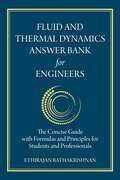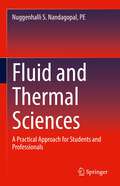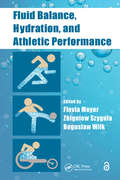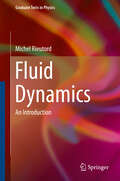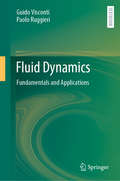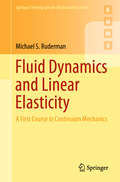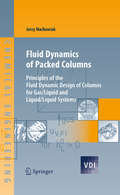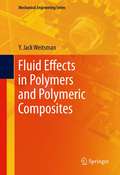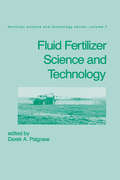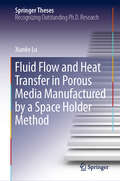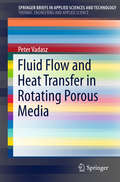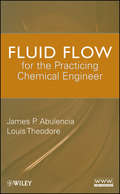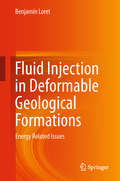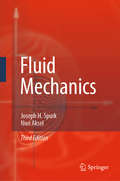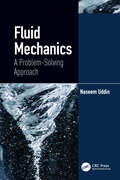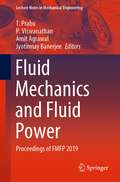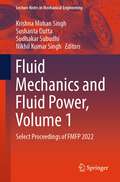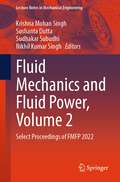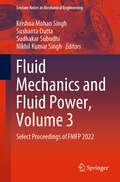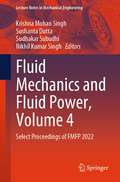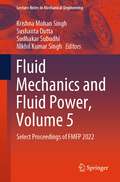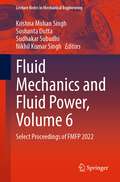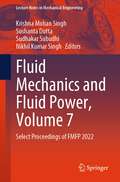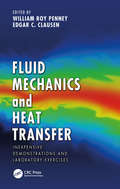- Table View
- List View
Fluid and Thermal Dynamics Answer Bank for Engineers: The Concise Guide with Formulas and Principles for Students and Professionals
by Ethirajan RathakrishnanThis book provides the essence of aerodynamics, fluid mechanics, experimental methods, gas dynamics, high enthalpy gas dynamics, helicopter aerodynamics, heat transfer, and thermodynamics, describing the underlying principles of these subjects before list
Fluid and Thermal Sciences: A Practical Approach for Students and Professionals
by Nuggenhalli S. Nandagopal, PEThis text provides a clear understanding of the fundamental principles of thermal and fluid sciences in a concise manner in a rigorous yet easy to follow language and presentation. Elucidation of the principles is further reinforced by examples and practice problems with detailed solutions. Firmly grounded in the fundamentals, the book maximizes readers’ capacity to take on new problems and challenges in the field of fluid and thermal sciences with confidence and conviction. Standing also as a ready reference and review of the essential theories and their applications in fluid and thermal sciences, the book is applicable for undergraduate mechanical and chemical engineering students, students in engineering technology programs, as well as practicing engineers preparing for the engineering license exams (FE and PE) in USA and abroad.Explains the concepts and theory with a practical approach that readers can easily absorb;Provides the just the right amount of theoretical and mathematical background needed, making it less intimidating for the reader;Covers fluid and thermal sciences in a straight-forward yet comprehensive manner facilitating a good understanding of the subject matter;Includes a wide spectrum and variety of problems along with numerous illustrative solved examples and many practice problems with solutions.
Fluid Balance, Hydration, and Athletic Performance
by Flavia MeyerAthletes and nonathletes frequently consume too little water or fluids, affecting exercise performance as well as overall health. This book comprehensively reviews the aspects relating to body fluid balance, rehydration, and physical exercise. It provides background on body water balance and turnover, topics related to electrolyte balance, and sweating as the basis for thermoregulatory and fluid homeostasis during exercise. In addition, chapters cover body water balance evaluation and regulation; cardiovascular and metabolic responses to fluid imbalance; effects of dehydration on aerobic power, muscle strength, and cognitive function; fluid intake timing; and optimal beverage selection.
Fluid Dynamics: An Introduction (Graduate Texts in Physics)
by Michel RieutordThis book is dedicated to readers who want to learn fluid dynamics from the beginning. It assumes a basic level of mathematics knowledge that would correspond to that of most second-year undergraduate physics students and examines fluid dynamics from a physicist’s perspective. As such, the examples used primarily come from our environment on Earth and, where possible, from astrophysics. The text is arranged in a progressive and educational format, aimed at leading readers from the simplest basics to more complex matters like turbulence and magnetohydrodynamics. Exercises at the end of each chapter help readers to test their understanding of the subject (solutions are provided at the end of the book), and a special chapter is devoted to introducing selected aspects of mathematics that beginners may not be familiar with, so as to make the book self-contained.
Fluid Dynamics: Fundamentals and Applications
by Guido Visconti Paolo RuggieriThis introductory book addresses a broad range of classical Fluid Dynamics topics, interesting applications, and related problems in everyday life. The geophysical and astrophysical applications discussed concern e.g. the shape and internal structure of the Earth and stars, the dynamics of the atmosphere and ocean, hydrodynamic instabilities, and the different kinds of waves that can be found in the atmosphere, ocean and solid Earth. Non-linear waves (solitons) are also mentioned. In turn, the book explores problems from everyday life, including the motion of golf balls, life at low Reynolds numbers, the physics of sailing, and the aerodynamics of airplanes and Grand Prix cars. No book on this topic would be complete without a look at chaos and turbulence; here the problems span from Gaussian plumes to chaotic dynamos, to stochastic climate modeling. Advances in fluid dynamics have produced a wealth of numerical methods and techniques, which are used in many of the applications. Given its structure, the book can be used both for an introductory course to fluid dynamics and as preparation for more advanced problems typical of graduate-level courses.
Fluid Dynamics and Linear Elasticity: A First Course in Continuum Mechanics (Springer Undergraduate Mathematics Series)
by Michael S. RudermanThis book provides a concise introduction to continuum mechanics, with a particular emphasis on fluid dynamics, suitable for upper undergraduate students in applied mathematics and related subjects.Starting with a preliminary chapter on tensors, the main topic of the book begins in earnest with the chapters on continuum kinematics and dynamics. Following chapters cover linear elasticity and both incompressible and compressible fluids. Special topics of note include nonlinear acoustics and the theory of motion of viscous thermal conducting compressible fluids.Based on an undergraduate course taught for over a decade, this textbook assumes only familiarity with multivariate calculus and linear algebra. It includes many exercises with solutions and can serve as textbook for lecture courses at the undergraduate and masters level.
Fluid Dynamics of Packed Columns
by Claudia Hall Jerzy MackowiakThis book provides support to engineers as well as graduate students in their daily design work within the industry or for the development of new plants. It investigates the key issues relating to the fluid dynamic design of packed columns used in rectification, absorption and stripping (desorption) under vacuum, normal pressure and up to 100 bar and liquid-liquid-extraction, which are relevant in waste air and wastewater technology. The author presents a standardised model, which is valid for any type of packing and can be used to calculate the gas velocity at flooding point as well as the liquid hold-up and the pressure drop throughout the entire operating range for random packings, stacked packings elements, tube columns and structured packings with different flow channel angles. The book also contains packing parameter data for approx. 200 random and structured packings. In addition to outlining the fundamental principles of fluid dynamics, it presents numerous examples of practical application.
Fluid Effects in Polymers and Polymeric Composites
by Y. Jack WeitsmanFluid Effects in Polymers and Polymeric Composites, written by the late Dr. Y. Jack Weitsman, addresses the wide range of parameters that affect the interaction of fluids with polymers and polymeric composites. The book aims at broadening the scope of available data, mostly limited up to this time to weight-gain recordings of fluid ingress into polymers and composites, to the practical circumstances of fluctuating exposure. Various forms of experimental data are given, in conjunction with theoretical models derived from basic scientific principles, and correlated with severity of exposure conditions and interpreted by means of rationally based theoretical models. The practical implications of the effects of fluids are discussed. The issue of fluid effects on polymers and polymeric composites is of concern to engineers and scientists active in aerospace and naval structures, as an increasing portion of these structures are made of polymeric composites and employ polymeric adhesives as a joining device. While the book is intended for this audience, it will also interest researchers and graduate students interested in the mechanics and materials aspects of this matter.
Fluid Fertilizer Science and Technology: Proceedings No 514
by Derek A. PalgraveIllustrates current fluid fertilizer technology in the US and abroad, including manufacture, handling, storage, distribution, and use in the field demonstrating how fluid fertilizer facilitates more precise delivery of nutrition to crops. The volume provides the means to analyze fluid fertilizer sys
Fluid Flow and Heat Transfer in Porous Media Manufactured by a Space Holder Method (Springer Theses)
by Xianke LuThis book focuses on the effects of the material, porosity, pore size and pore shape on flow behaviour and heat transfer in microscale porous media manufactured using a space holder method. It also describes a novel approach to studying flow behaviour in non-transparent materials such as porous metals via flow visualization in transparent media that mimic the porous structure. The book employs a combination of microparticle image velocimetry – a modern, advanced technique – and pressure drop measurement – a more traditional method – that makes the mechanistic study of several phenomena possible. It covers the identification of various flow regimes and their boundaries, velocity profiles on the microscale, the heat transfer coefficient under forced convection, and the correlation between flow behaviour on the pore scale and the convective heat transfer performance of the porous media. Understanding the fundamentals of porous flow, especially on the microscale, is critical for applications of porous media in heat exchangers, catalytic convertors, chemical reactors, filtration and oil extraction. Accordingly, this book offers a valuable resource for all researchers, graduate students and engineers working in the areas of porous flow and porous materials.
Fluid Flow and Heat Transfer in Rotating Porous Media
by Peter VadaszThis Book concentrates the available knowledge on rotating fluid flow and heat transfer in porous media in one single reference. Dr. Vadasz develops the fundamental theory of rotating flow and heat transfer in porous media and introduces systematic classification and identification of the relevant problems. An initial distinction between rotating flows in isothermal heterogeneous porous systems and natural convection in homogeneous non-isothermal porous systems provides the two major classes of problems to be considered. A few examples of solutions to selected problems are presented, highlighting the significant impact of rotation on the flow in porous media.
Fluid Flow for the Practicing Chemical Engineer
by James P. Abulencia Louis TheodoreThis book teaches the fundamentals of fluid flow by including both theory and the applications of fluid flow in chemical engineering. It puts fluid flow in the context of other transport phenomena such as mass transfer and heat transfer, while covering the basics, from elementary flow mechanics to the law of conservation. The book then examines the applications of fluid flow, from laminar flow to filtration and ventilization. It closes with a discussion of special topics related to fluid flow, including environmental concerns and the economic reality of fluid flow applications.
Fluid-Induced Seismicity
by Serge A. ShapiroThe characterisation of fluid transport properties of rocks is one of the most important, yet difficult, challenges of reservoir geophysics, but is essential for optimal development of hydrocarbon and geothermal reservoirs. This book provides a quantitative introduction to the underlying physics, application, interpretation, and hazard aspects of fluid-induced seismicity with a particular focus on its spatio-temporal dynamics. It presents many real data examples of microseismic monitoring of hydraulic fracturing at hydrocarbon fields and of stimulations of enhanced geothermal systems. The author also covers introductory aspects of linear elasticity and poroelasticity theory, as well as elements of seismic rock physics and mechanics of earthquakes, enabling readers to develop a comprehensive understanding of the field. Fluid-Induced Seismicity is a valuable reference for researchers and graduate students working in the fields of geophysics, geology, geomechanics and petrophysics, and a practical guide for petroleum geoscientists and engineers working in the energy industry.
Fluid Injection in Deformable Geological Formations: Energy Related Issues
by Benjamin LoretThis book offers an introduction to the geomechanical issues raised by both the extraction of actual and potential energy resources, and by the treatment of the ensuing environmental concerns. Discussions of the operations of injection of fluids into, and withdrawal from, geological formations link the chapters, each devoted to a particular technical aspect or scientific issue, or to a particular energy resource.Subjects are ordered according to their industrial applications, including enhanced oil and gas recovery, gas hydrates, enhanced geothermal systems, hydraulic fracturing, and carbon dioxide sequestration. An overview of the industrial, research and simulation aspects for each subject is provided. Fluid Injection in Deformable Geological Formations will be of interest to academic and industrial researchers in a wide variety of fields, including computational mechanics, civil engineering, geotechnical engineering and geomechanics, engineering seismology, petroleum engineering, reservoir engineering, and engineering geology.
Fluid Mechanics: Problems And Solutions
by Nuri Aksel Joseph H. SpurkThis successful textbook emphasizes the unified nature of all the disciplines of Fluid Mechanics as they emerge from the general principles of continuum mechanics. The different branches of Fluid Mechanics, always originating from simplifying assumptions, are developed according to the basic rule: from the general to the specific. The first part of the book contains a concise but readable introduction into kinematics and the formulation of the laws of mechanics and thermodynamics. The second part consists of the methodical application of these principles to technology. In addition, sections about thin-film flow and flow through porous media are included.
Fluid Mechanics: A Problem-Solving Approach
by Naseem UddinFluid Mechanics: A Problem-Solving Approach provides a clear distinction between integral formulation and the different formulation of conservation law. Including a detailed discussion on pipe flow correlations, entrance length correlations, and plotting of Moody diagram, the book works through the comprehensive coverage of fluid mechanics with a gradual introduction of theory in a straightforward, practical approach. The book includes numerous end-of-chapter problems to enhance student understanding and different solving approaches. It features chapters on nanofluids, jets, waves in ocean and rivers, boundary layer separation, and Thwaites integral method, which are not typically covered in an introductory course. Features Provides a comprehensive treatment of fluid mechanics from the basic concepts to in-depth application problems. Covers waves and tsunamis. Offers two distinct chapters on jet flows and turbulent flows. Includes numerous end-of-chapter problems. Includes a Solutions Manual and MAPLE worksheets for instructor use. The book is intended for senior undergraduate mechanical and civil engineering students taking courses in fluid mechanics. The eBook+ version includes the following enhancements: 3 videos placed throughout the text to help apply real-world examples to concepts of Newtonian vs. Non-Newtonian fluids, vortices, and additional information on surface tension. Pop-up explanations of selected concepts as interactive flashcards in each chapter. Quizzes within chapters to help readers refresh their knowledge.
Fluid Mechanics and Fluid Power: Proceedings of FMFP 2019 (Lecture Notes in Mechanical Engineering)
by T. Prabu P. Viswanathan Amit Agrawal Jyotirmay BanerjeeThis book comprises select proceedings of the 46th National Conference on Fluid Mechanics and Fluid Power (FMFP 2019). The contents of this book focus on aerodynamics and flow control, computational fluid dynamics, fluid structure interaction, noise and aero-acoustics, unsteady and pulsating flows, vortex dynamics, nuclear thermal hydraulics, heat transfer in nanofluids, etc. This book serves as a useful reference beneficial to researchers, academicians and students interested in the broad field of mechanics.^
Fluid Mechanics and Fluid Power, Volume 1: Select Proceedings of FMFP 2022 (Lecture Notes in Mechanical Engineering)
by Krishna Singh Sushanta Dutta Sudhakar Subudhi Nikhil SinghThis book comprises select peer-reviewed proceedings of the 9th International and 49th National Conference on Fluid Mechanics and Fluid Power (FMFP 2022). This book brings together scientific ideas and engineering solutions put forth by researchers and practitioners from academia and industry in the important and ubiquitous field of fluid mechanics. The contents of this book focus on fundamental issues and perspective in fluid mechanics, measurement techniques in fluid mechanics, computational fluid and gas dynamics, instability, transition and turbulence, fluid-structure interaction, multiphase flows, microfluidics, bio-inspired fluid mechanics, aerodynamics, turbomachinery, propulsion and power and other miscellaneous topics in the broad domain of fluid mechanics. This book is a useful reference to researchers and professionals working in the broad field of mechanics.
Fluid Mechanics and Fluid Power, Volume 2: Select Proceedings of FMFP 2022 (Lecture Notes in Mechanical Engineering)
by Krishna Mohan Singh Sushanta Dutta Sudhakar Subudhi Nikhil Kumar SinghThis book comprises select peer-reviewed proceedings of the 9th International and 49th National Conference on Fluid Mechanics and Fluid Power (FMFP 2022). This book brings together scientific ideas and engineering solutions put forth by researchers and practitioners from academia and industry in the important and ubiquitous field of fluid mechanics. The contents of this book focus on fundamental issues and perspective in fluid mechanics, measurement techniques in fluid mechanics, computational fluid and gas dynamics, instability, transition and turbulence, fluid-structure interaction, multiphase flows, microfluidics, bio-inspired fluid mechanics, aerodynamics, turbomachinery, propulsion and power and other miscellaneous topics in the broad domain of fluid mechanics. This book is a useful reference to researchers and professionals working in the broad field of mechanics.
Fluid Mechanics and Fluid Power, Volume 3: Select Proceedings of FMFP 2022 (Lecture Notes in Mechanical Engineering)
by Krishna Mohan Singh Sushanta Dutta Sudhakar Subudhi Nikhil Kumar SinghThis book comprises select peer-reviewed proceedings of the 9th International and 49th National Conference on Fluid Mechanics and Fluid Power (FMFP 2022). This book brings together scientific ideas and engineering solutions put forth by researchers and practitioners from academia and industry in the important and ubiquitous field of fluid mechanics. The contents of this book focus on fundamental issues and perspective in fluid mechanics, measurement techniques in fluid mechanics, computational fluid and gas dynamics, instability, transition and turbulence, fluid-structure interaction, multiphase flows, microfluidics, bio-inspired fluid mechanics, aerodynamics, turbomachinery, propulsion and power and other miscellaneous topics in the broad domain of fluid mechanics. This book is a useful reference to researchers and professionals working in the broad field of mechanics.
Fluid Mechanics and Fluid Power, Volume 4: Select Proceedings of FMFP 2022 (Lecture Notes in Mechanical Engineering)
by Krishna Mohan Singh Sushanta Dutta Sudhakar Subudhi Nikhil Kumar SinghThis book comprises select peer-reviewed proceedings of the 9th International and 49th National Conference on Fluid Mechanics and Fluid Power (FMFP 2022). This book brings together scientific ideas and engineering solutions put forth by researchers and practitioners from academia and industry in the important and ubiquitous field of fluid mechanics. The contents of this book focus on fundamental issues and perspective in fluid mechanics, measurement techniques in fluid mechanics, computational fluid and gas dynamics, instability, transition and turbulence, fluid-structure interaction, multiphase flows, microfluidics, bio-inspired fluid mechanics, aerodynamics, turbomachinery, propulsion and power and other miscellaneous topics in the broad domain of fluid mechanics. This book is a useful reference to researchers and professionals working in the broad field of mechanics.
Fluid Mechanics and Fluid Power, Volume 5: Select Proceedings of FMFP 2022 (Lecture Notes in Mechanical Engineering)
by Krishna Mohan Singh Sushanta Dutta Sudhakar Subudhi Nikhil Kumar SinghThis book comprises select peer-reviewed proceedings of the 9th International and 49th National Conference on Fluid Mechanics and Fluid Power (FMFP 2022). This book brings together scientific ideas and engineering solutions put forth by researchers and practitioners from academia and industry in the important and ubiquitous field of fluid mechanics. The contents of this book focus on fundamental issues and perspective in fluid mechanics, measurement techniques in fluid mechanics, computational fluid and gas dynamics, instability, transition and turbulence, fluid-structure interaction, multiphase flows, microfluidics, bio-inspired fluid mechanics, aerodynamics, turbomachinery, propulsion and power and other miscellaneous topics in the broad domain of fluid mechanics. This book is a useful reference to researchers and professionals working in the broad field of mechanics.
Fluid Mechanics and Fluid Power, Volume 6: Select Proceedings of FMFP 2022 (Lecture Notes in Mechanical Engineering)
by Krishna Mohan Singh Sushanta Dutta Sudhakar Subudhi Nikhil Kumar SinghThis book comprises select peer-reviewed proceedings of the 9th International and 49th National Conference on Fluid Mechanics and Fluid Power (FMFP 2022). This book brings together scientific ideas and engineering solutions put forth by researchers and practitioners from academia and industry in the important and ubiquitous field of fluid mechanics. The contents of this book focus on fundamental issues and perspective in fluid mechanics, measurement techniques in fluid mechanics, computational fluid and gas dynamics, instability, transition and turbulence, fluid-structure interaction, multiphase flows, microfluidics, bio-inspired fluid mechanics, aerodynamics, turbomachinery, propulsion and power and other miscellaneous topics in the broad domain of fluid mechanics. This book is a useful reference to researchers and professionals working in the broad field of mechanics.
Fluid Mechanics and Fluid Power, Volume 7: Select Proceedings of FMFP 2022 (Lecture Notes in Mechanical Engineering)
by Krishna Mohan Singh Sushanta Dutta Sudhakar Subudhi Nikhil Kumar SinghThis book comprises select peer-reviewed proceedings of the 9th International and 49th National Conference on Fluid Mechanics and Fluid Power (FMFP 2022). This book brings together scientific ideas and engineering solutions put forth by researchers and practitioners from academia and industry in the important and ubiquitous field of fluid mechanics. The contents of this book focus on fundamental issues and perspective in fluid mechanics, measurement techniques in fluid mechanics, computational fluid and gas dynamics, instability, transition and turbulence, fluid-structure interaction, multiphase flows, microfluidics, bio-inspired fluid mechanics, aerodynamics, turbomachinery, propulsion and power and other miscellaneous topics in the broad domain of fluid mechanics. This book is a useful reference to researchers and professionals working in the broad field of mechanics.
Fluid Mechanics and Heat Transfer: Inexpensive Demonstrations and Laboratory Exercises
by William Roy Penney and Edgar C. ClausenThis practical book provides instruction on how to conduct several "hands-on" experiments for laboratory demonstration in the teaching of heat transfer and fluid dynamics. It is an ideal resource for chemical engineering, mechanical engineering, and engineering technology professors and instructors starting a new laboratory or in need of cost-effective and easy to replicate demonstrations. The book details the equipment required to perform each experiment (much of which is made up of materials readily available is most laboratories), along with the required experimental protocol and safety precautions. Background theory is presented for each experiment, as well as sample data collected by students, and a complete analysis and treatment of the data using correlations from the literature.
